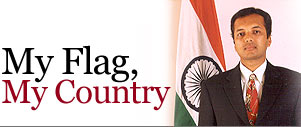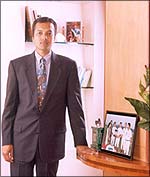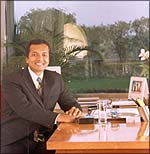The Rediff Special/Ramesh Menon

"It will be necessary for us Indians -- Hindus, Muslims, Christians, Jews, Parsis and all others to whom India is their home -- to recognise a common flag to live and die for."
-- Mahatma Gandhi
July 22, 1947. As he moved the motion on the adoption of the national flag in independent India's Constituent Assembly, Prime Minister Jawaharlal Nehru hoped the flag would carry a message of freedom wherever it flew.
Other voices joined him. Sarojini Naidu said: "Under this flag, there is no prince and there is no peasant, no rich and no poor. There is only duty, responsibility and sacrifice."
Freedom fighter Muniswami Pillai added that the flag did not belong to the rich or the wealthy, but to the depressed, oppressed and submerged classes.
Inspiring words.
Unfortunately, as time passed, the use of the Indian flag became limited to a privileged few. Only VVIPs, government offices and public sector undertakings were allowed the honour of displaying the flag on their premises. The rest of India could fly the Tricolour only on Independence Day, Republic Day and Mahatma Gandhi's birthday.
Yet, in a country where millions dedicated their life to the freedom struggle, no one protested. Until recently, when a spirited 31-year-old businessman called Naveen Jindal secured, through a legal battle, the temporary right to fly the national flag every day. The Supreme Court is expected to deliver final judgment on the matter in July.
Meanwhile, an ecstatic Jindal displays the flag outside his office in the posh R K Puram area in New Delhi. He even has two small flags adorning his desk. "Indians have never been allowed to fly their flag," he says. "First it was monarchs who flew it. Then, it was the Mughals, who were followed by the British. After we became independent, the use of the national flag became a symbol of power that was limited to a few government officials. Do you realise that if Mahatma Gandhi were alive today and not a minister, even he would not have been able to fly the flag?"
Jindal's fascination with the Tricolour began during his visit to the United States in 1990, where he studied for a master's degree in business management at the University of Texas at Dallas. One of the first things he noticed was the ubiquitous fluttering of the American flag all over the country. The Americans even patterned the flag on their clothes.
Then, on a casual visit to a Texas-based Punjabi businessman, he noticed a framed Tricolour in a position of pride in his host's living room. Jindal could not recall seeing the flag displayed with such reverence in any home in India. Yet, he was suddenly homesick.
The moment passed.
Soon, his popularity saw him elected president of his university students' government. One of the perks of that position was his own office room, where he wanted to display the Indian flag. The university had no objection. Neither did his American friends. In fact, within hours of him expressing this desire, an American student gifted him a huge nylon Tricolour.
"It was the first time I had held my country's flag," Jindal recalls. "It felt great." The flag soon became a point of conversation as visitors began asking him about it, about the Indian people and India.
 Jindal returned home in 1992 to take over as joint managing director of Jindal Strips Limited. He was soon busy heading the Raigarh and Raipur plants.
Jindal returned home in 1992 to take over as joint managing director of Jindal Strips Limited. He was soon busy heading the Raigarh and Raipur plants.
Then came the turning point.
On January 26, 1993, he hoisted the flag at his Raigarh factory. The next day, it was no longer there. When questioned, the factory manager explained that the flag could not be displayed daily. Jindal was shocked and furious; he ordered the manager to hoist it back.
"The flag looked so good," Jindal remembers. "It was a symbolic way of showing our love for our country. Psychologically too, it was great. The workers felt they were working for their country, not for a company. The one common thing that bound us together in our office was the flag."
Raigarh's collector, superintendent of police and other senior government officials would occasionally hint that Jindal was not allowed to display the flag. None of them, though, could counter his argument: "If I cannot fly my flag in my country, where else can I fly it?"
September 1994. S K Dubey, then commissioner of Bilaspur, was staying at the Jindal Group's guest house, located within the factory's premises in Raigarh. As he casually looked out of his window, his unbelieving eyes fell on the fluttering Tricolour. Angry inquiries elicited the information that it had been flying there every day for more than a year.
Dubey ordered the superintendent of police to personally take the flag down. Jindal, who was then in New Delhi, received a nervous call from his factory officials.
"I was very upset," recalls Jindal. "How could they humiliate us like this in independent India? We were flying the flag with utmost respect."
The incident strengthened Jindal's resolve. "I decided I would fight for my right to fly the flag."
First, he studied the Constitution. Then, he approached Shanti Bhushan, a reputed lawyer with a penchant for public interest causes. He even consulted some of the country's renowned legal brains -- including Arun Jaitley, Harish Salve, K K Venugopal and Soli Sorabjee. [Jaitley is now Union Minister for Law, Justice and Company Affairs and Sorabjee is India's Attorney General.]
Though Jindal will not reveal how much he has spent so far -- he claims never having tried to calculate -- he says he has been charged reasonable fees. Sorabjee, in particular, has not even sent a bill.
Jindal was told there were two clear laws on the subject.
The first, the Prevention of Insults to National Honour Act (1971), says the flag cannot be mutilated, burned, defaced, torn or trampled upon. Offenders can be jailed for up to three years or fined. But it does not prevent anyone from flying the flag in a respectful manner.
The second law, the Emblems and Names (Prevention of Improper Use) Act (1950), says the national flag or national emblem cannot be used for commercial purposes. Nor can it be used as packaging.
Jindal relaxed. He had not broken the law.
So, in October, he wrote a letter to the commissioner of Bilaspur and the home affairs ministry, saying he was flying the flag in his office premises out of patriotism and that it inspired him. No Indian law, he added, prohibited him from flying the flag.
Jindal's officials tried to caution him against sending the letter. They did not think it was prudent to annoy government officials, particularly since they had a loss-making industrial unit on their hands. But Jindal remembered what his father, O P Jindal, had always told him: "If you are in the right, God will be with you. No harm can come to anyone fighting for a just cause."
He sent the letter. But there was no reply. He shot off a reminder. The commissioner of Bilaspur finally replied, saying that everybody could not fly the flag. Only certain people, he said, could fly it and improper use of the flag could invite punishment. The home ministry explained that only certain high dignitaries could fly the flag on their residences.
Jindal was appalled. "The government had turned the national flag into a government flag."
The Flag Code of India says the national flag should be flown on the official residences of the president, vice-president, governors and lieutenant governors. But the code is an executive instruction; it has not been passed by Parliament. "You cannot take away a fundamental right of the people on the basis of an executive decision," says Jindal.
On February 2, 1995, Jindal filed a writ petition in the Delhi high court, requesting that all Indians and institutions be allowed to fly the flag in a respectful manner. At that time, he did not realise he was beginning a court battle that would last six long years.
Says Jindal: "Javed Akhtar once said the moon helps connect two lovers, irrespective of the distance that keeps them apart. I think it is the same with the Tricolour. When a person flies the national flag, he rises above his religion and political affiliations and shows that he is a proud Indian. We are a diverse group of people and this is one way to bind all of us."
 In September 1995, the high court allowed Jindal to fly the national flag on his premises. Its judgment quoted former president R Venkataraman: "Our flag contains the blessings of all those great souls who brought us to freedom. It beckons us to fulfil their vision of a just and united India. As we confront crucial challenges to our security, our unity and integrity, we cannot but heed the call of this flag to rededicate ourselves to the establishment of that peaceful and just order wherein all Indians irrespective of creed, caste or sex will fulfil themselves."
In September 1995, the high court allowed Jindal to fly the national flag on his premises. Its judgment quoted former president R Venkataraman: "Our flag contains the blessings of all those great souls who brought us to freedom. It beckons us to fulfil their vision of a just and united India. As we confront crucial challenges to our security, our unity and integrity, we cannot but heed the call of this flag to rededicate ourselves to the establishment of that peaceful and just order wherein all Indians irrespective of creed, caste or sex will fulfil themselves."
Jindal started flying the flag again.
But, in January 1996, the Government of India appealed against this judgment. In its special leave petition to the Supreme Court, the government said the policy to restrict the use of the national flag to the barest minimum was meant to ensure that it was not dishonoured. Jindal, it said, had taken a questionable position by imagining that one of the ways of showing his patriotism and love for the country was to fly the flag. The petition pointed out that there were millions of Indians who were not swayed by a desire to fly the flag in their houses.
The apex court, on February 7 that year, stayed the high court's judgement. As a dejected Jindal took down his flag, his lawyer stopped him. Shanti Bhushan explained that he could continue flying the flag; it would not be contempt of court since the judgment had only been stayed.
At that point, his workers went to him saying they also wanted to fly the flag. An embarrassed Jindal recalls telling them only he would do so. In the seconds that followed, though, he felt a strong sense of remorse. His fight, after all, was to give every Indian the right to fly the national flag.
When the Raigarh collector noticed the flag flying again, he sent an angry letter to the home ministry. The Government of India then filed a contempt of court case against Jindal, which has now been clubbed with the main case. Jindal explained to the court that he had utmost respect for the judiciary and was not trying to defy it or mean any disrespect by hoisting the flag.
The government, meanwhile, formed an inter-ministerial committee headed by P D Shenoy, additional secretary in the Union home ministry, to decide whether it could permit the flag to be flown freely.
Jindal met Shenoy and the other committee members to share with them his belief that the common man would not disrespect the flag. He explained that, like the idols that people keep in their houses, the flag too would be venerated.
In mid-April 2001, the government announced its decision to liberalise use of the national flag.
On May 1 this year, Jindal's case again came up for hearing. Asking the government to give a copy of the Shenoy Committee's report to Jindal's counsel, the court reconvened for the next day.
On May 2, Jindal's counsel complained that he had not received the report. The court, taking strong exception to the government's argument that the report was privileged, modified its February 7, 1996, order.
Jindal hoisted the flag. "Let us think of the millions of people who died after Independence without having the pleasure of flying the flag. I would have hated to tell my son that he could not fly the Tricolour as he was not a minister. Why should we presume that commoners will not respect the flag? We have to trust the people. It is their flag. If someone disrespects it, there is a law to deal with it."
Once the court announces its final judgement -- this is expected to happen some time next month -- Jindal hopes every Indian will be free to fly the national flag.
"We should be able to celebrate our independence everyday. If we can fly our flag, we will be a much prouder nation, a much happier nation. We will psychologically think of our nation before we think of ourselves."
Page design: Dominic Xavier
The Rediff Specials